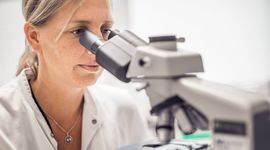The Gratz Working Group
Specific cells in the skin can recognise foreign or altered skin cells and render them harmless. The knowledge gained from research into the functioning of these immune cells is used to positively influence various therapy options for EB.
The skin is an active immune organ. It contains millions of specialised cells tasked with recognising and destroying “foreign” invaders or altered skin cells. These include dangerous bacteria, malignant cells and, in the case of EB, proteins (or parts of proteins) that have never been present in the patient before, because they have been introduced through gene therapy. Every aspect of the course of an EB patient’s disease is influenced by the skin immune system.

„The skin's immune system controls its "fitness". We want to use this for EB patients.”
Iris Gratz, PhD, Head of the Gratz Working Group
There are around 20 billion immune cells (called T-cells) in the skin – about twice as many as there are in the blood. There are also many different types of T-cells, and each has a different function. For example, some cells are activated to destroy abnormal or virus-infected cells (killer cells), while others try to limit this type of tissue damage (regulatory T-cells). The balance among these cell types is essential for the correct functioning of the skin. Our research is focused on understanding and using the functions of the different T-cells in the skin to improve critical aspects of EB:
Wound healing: A T-cell subgroup that supports wound healing
Working in cooperation with Daniel J. Campbell (Benaroya Research Institute, Seattle, USA), we found a special T-cell type in human skin and blood. These CD103+ T-cells not only play a role in the defence against invading microbes, we presume that they also directly support wound healing in the skin. The development of these cells could be a new strategy to improve wound healing in EB.
Cancer: Using the skin’s killer cells
The immune system can recognise altered or stressed cells and efficiently eliminate them. Specialised cells called GammaDelta T-cells, guard the skin. In collaboration with GammaDeltaTherapeutics, we are attempting to use these cells to limit the growth of skin cancer.
Gene therapy: Regulatory T-cells, the masters of tolerance
The ability of the immune system to differentiate “own” and “foreign” and to attack foreign or altered cells can lead to the rejection of genetically modified skin tissue. Regulatory T-cells are the body’s own “brakes” that slow this unwanted immune reaction. This is why we are researching how to multiply these cells and making them more efficient, in order to make the gene therapy treatment as sustainable as possible.


